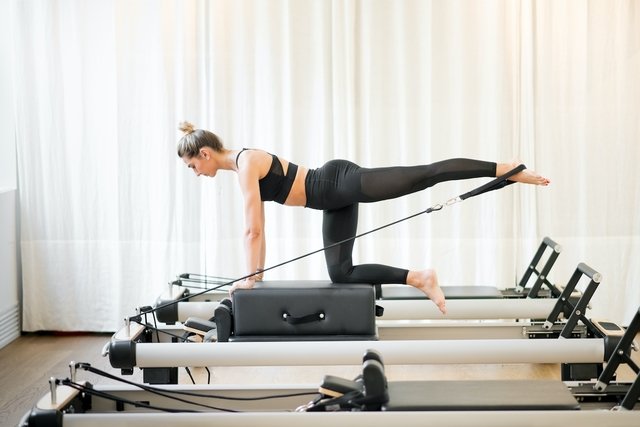Pilates is a great type of exercise for increasing flexibility and toning muscles, as well as combating pain, improving posture, increasing strength, toning and promoting muscle formation. This increase in muscle mass helps speed up metabolism as muscles use more energy than fat cells, which is essential for eliminating excess weight and helping you lose weight.
However, the main objective of Pilates is not weight loss, and to achieve this result, Pilates must be combined with a balanced diet guided by a nutritionist and the practice of other physical activity with high caloric expenditure, such as running, swimming or Muay Thay, for example.
Read too: Pilates on the wall: what it is, what it’s for (and how to do it)
It is important to consult your doctor before starting Pilates to assess your physical and cardiac conditions, in order to perform the exercises safely, guided by a physiotherapist or physical educator.

How does pilates lose weight?
Pilates is a type of exercise that works the entire body, toning the muscles in the stomach, legs, arms and buttocks, and increasing muscle tone and strength, which contributes to accelerating metabolism and helping you lose weight. Furthermore, Pilates improves your mood, giving you more energy and enthusiasm to perform other physical activities that help you lose weight. Check out the best exercises to help you lose weight.
Pilates is also a great way to reduce stress and anxiety, which are often factors that lead to increased calorie intake, contributing to weight gain. In this way, Pilates can help control the desire to eat high-calorie foods, promoting weight loss.
Furthermore, Pilates, as it is a simple, non-impact form of physical activity that works the entire body, is a good way to start practicing physical exercise, especially for people who do not do any type of exercise.
How many calories does pilates burn?
Pilates classes last approximately 1 hour and have a caloric expenditure of between 200 and 400 calories, depending on the exercises performed.
The best professionals to teach Pilates classes are the physical educator and the physiotherapist with proper knowledge of the method. Find out which pilates exercises are the most recommended.
Other physical activities are also good options for losing weight. Enter your data below and find out how many calories you burn when exercising:
How long does it take for Pilates to lose weight?
A scientific article published in 2017 (1) states that practicing Pilates for approximately 8 weeks is capable of reducing body weight, reducing BMI, toning the waist and reducing the belly and hip circumference.
Even if these numbers are not reflected directly on the scale, regular practice of physical exercises such as Pilates helps you lose weight because it accelerates metabolism and promotes muscle formation, which increases caloric expenditure even when standing still. The results can be seen at the end of the first month of classes and others will be able to observe the new curves in approximately 6 months.
Watch the following video with other tips on how to reduce body fat and increase muscle to lose weight:
Other benefits of pilates
In addition to helping you lose weight, Pilates has many benefits, in addition to being practiced by the elderly, adults, children, teenagers and pregnant women. Some of the main benefits of pilates are:
- Increases concentration;
- Relieves stress;
- Strengthens muscles, preventing injuries;
- Assists in recovery from injuries;
- Promotes muscle toning;
- Improved balance and posture;
- Improved breathing;
- Reduces back pain and prevents urinary incontinence, in the case of pregnant women;
- Increases flexibility;
- Improves mobility and motor coordination;
- Promotes increased performance in other physical activities.
Pilates requires the mind and body to be in tune, requiring a lot of concentration and breathing control so that the movements are performed correctly and can have several benefits.
The Pilates method allows you to work the entire body, with the most activated muscles being those of the abdomen, glutes and back. Check out other benefits of pilates.
Bibliography
- ALADRO-GONZALVO, AR; et al. The effect of Pilates exercises on body composition: a systematic review. J Bodyw Mov Ther. 16. 1; 109-14, 2012
- KAMIOKA, H.; et al. Effectiveness of Pilates exercise: A quality evaluation and summary of systematic reviews based on randomized controlled trials. Complement Ther Med. 25. 1-19, 2016
- SAVKIN, R.; ASLAN, U. B. The effect of Pilates exercise on body composition in sedentary overweight and obese women. J Sports With Phys Fitness. 57. 11; 1464-1470, 2017
- CABIN, APS; et al. Effects of the Mat Pilates Method on Body Composition: Systematic Review With Meta-Analysis. J Phys Act Health. 17. 6; 673-681, 2020

Sign up for our newsletter and stay up to date with exclusive news
that can transform your routine!
Warning: Undefined array key "title" in /home/storelat/public_html/wp-content/plugins/link-whisper-premium/templates/frontend/related-posts.php on line 12
Warning: Undefined array key "title_tag" in /home/storelat/public_html/wp-content/plugins/link-whisper-premium/templates/frontend/related-posts.php on line 13



